Clinical Library
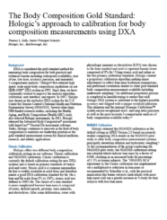
Authored by Tom Kelly, Hologic, Inc., this paper discusses how DXA continues to represent the... Show more
Authored by Tom Kelly, Hologic, Inc., this paper discusses how DXA continues to represent the gold standard
measurement system for body composition in clinical medicine, research, and athletic applications. Continued development and enhancement by Hologic scientists and engineers will keep Hologic DXA body composition applications on the forefront for years to come.

Authored by John Schousboe, MD, Park Nicollet Clinic & Specialty Center, MN, this... Show more
Authored by John Schousboe, MD, Park Nicollet Clinic & Specialty Center, MN, this whitepaper discusses how VFA imaging at the time of a bone density test is aconvenient and efficient way of identifying patients with one or more prevalent vertebral fractures. This aids in identifying those at high risk of subsequent fracture and for whom fracture prevention therapies are indicated.
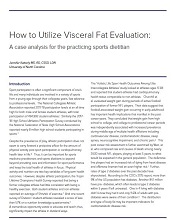
Authored by Jennifer Ketterly, University of North Carolina, in which she shares a case study... Show more
Authored by Jennifer Ketterly, University of North Carolina, in which she shares a case study about an athlete and Visceral Fat Assessment (VAT) made possible by the Horizon DXA™ System. She goes further into how VAT can be associated with cardiac and metabolic disorders. She also highlights how she uses Hologic DXA™ System with her female athlete with nutritional deficits, bone health concerns due to presenting stress fractures, and utilization of DXA for treatment plan and resolution. Read the Hologic white paper for the complete case analysis for the practicing sports dietitian.
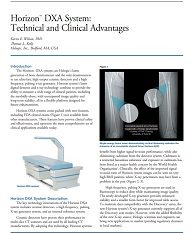
Introduction: The Horizon® DXA systems are Hologic’s latest generation of bone... Show more
Introduction: The Horizon® DXA systems are Hologic’s latest generation of bone densitometers and the only densitometers to use ultra-fast, high output ceramic detectors and a high frequency, pulsing x-ray generator. Horizon system’s latest digital detector and x-ray technology combine to provide the ability to measure a wide range of clinical patients, including the morbidly obese, with unsurpassed image quality and long-term stability, all in a flexible platform designed for future enhancements.

Abstract: Over the last decade obesity has exploded to epidemic proportions in America.... Show more
Abstract: Over the last decade obesity has exploded to epidemic proportions in America. Obesity-related health risks include coronary heart disease, type 2 diabetes, stroke, dyslipidemia,
and certain types of cancers. Traditional anthropomorphic measures of obesity like BMI and waist circumference quantify excess weight or size, not excess fat, and misclassify patients by failing to assess pathogenic visceral fat depots. DXA visceral fat measurements may be superior to traditional measures for evaluating obesity-related disease risk. The available literature supports visceral fat thresholds of 100 cm2 for increased risk and 160 cm2 for high risk and suggests this classification scheme may identify patients most likely to benefit from preventive interventions.
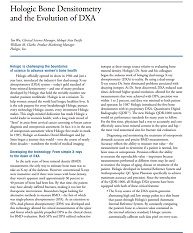
This paper addresses practical considerations for upgrading DXA systems that will help... Show more
This paper addresses practical considerations for upgrading DXA systems that will help clinicians properly migrate data and calibrate equipment, so that patient care is uninterrupted.

Practical considerations for upgrading DXA systems that will help clinicians properly migrate... Show more
Practical considerations for upgrading DXA systems that will help clinicians properly migrate data and calibrate equipment, so that patient care is uninterrupted.
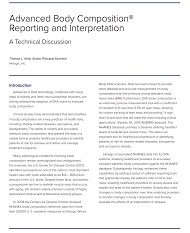
This paper presents a technical discussion of advanced body composition reporting and... Show more
This paper presents a technical discussion of advanced body composition reporting and interpretation. Clinical studies have demonstrated that abnormalities in body composition are a key predictor of health risks, including obesity-related diseases, sarcopenia, and lipodystrophy. The ability to reliably and accurately measure body composition, and present the data in a usable format, enables healthcare providers to identify patients at risk for disease and define and manage treatment programs.
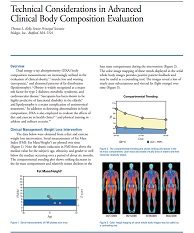
Overview: Dual energy x-ray absorptiometry (DXA) body composition measurements are increasingly... Show more
Overview: Dual energy x-ray absorptiometry (DXA) body composition measurements are increasingly utilized in the evaluation of clinical obesity,1,2 muscle loss and wasting (sarcopenia),3 and abnormal patterns of fat distribution (lipodystrophy).4 Obesity is widely recognized as a major risk factor for type 2 diabetes, metabolic syndrome, and cardiovascular disease.5 Sarcopenia has been shown to be highly predictive of functional disability in the elderly,6 and lipodystrophy is a major complication of antiretroviral treatments.7 In addition to detecting abnormalities in body composition, DXA is also employed to evaluate the effects of diet and exercise in health clinics8, 9 and physical training in athletes and military recruits.10
Page 1 of 1
